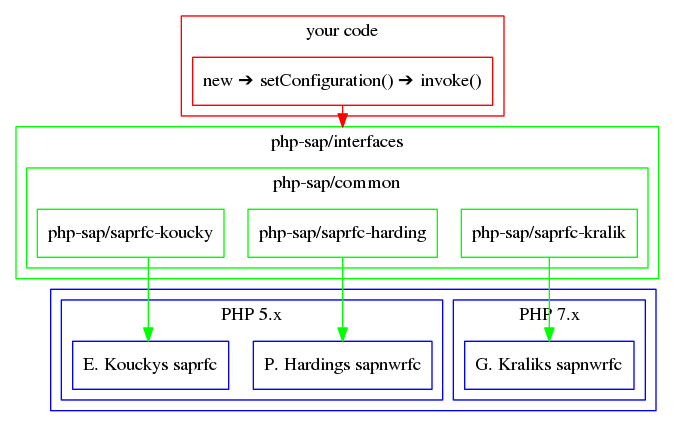About PHP/SAP
PHP/SAP defines a layer of abstraction between actual SAP remote function calls and your PHP-Code.
As to why this project has been created and which goals it wants to achieve, you can read the motivation.

The interfaces define a common denominator on how to configure a connection to SAP, prepare a SAP remote function call, and invoke a SAP remote function call.
The common classes and exceptions add logic that is not specific to the underlying PHP module.
The module specific implementations contain code that is specific to the underlying PHP-module.
TL;DR
Especially short explanation for people in a hurry.
Use composer require to add PHP/SAP to your project. Depending on the
PHP module you need to require a certain PHP/SAP package.
composer require php-sap/saprfc-koucky
or
composer require php-sap/saprfc-harding
or
composer require php-sap/saprfc-kralik
<?php
//Include the composer autoloader ...
require_once 'vendor/autoload.php';
//... and add the namespaces of the classes used.
use phpsap\classes\Config\ConfigTypeA;
use phpsap\DateTime\SapDateTime;
use phpsap\saprfc\SapRfc;
/**
* Create an instance of the SAP remote function using its
* name, input parameters, and connection configuration.
*
* The imaginary SAP remote function requires a
* date as input and will return a date as output.
*
* In this case the configuration array is defined manually.
*/
$result = (new SapRfc(
'MY_COOL_SAP_REMOTE_FUNCTION',
[
'IV_DATE' => (new DateTime('2019-12-31'))
->format(SapDateTime::SAP_DATE)
],
new ConfigTypeA([
ConfigTypeA::JSON_ASHOST => 'sap.example.com',
ConfigTypeA::JSON_SYSNR => '999',
ConfigTypeA::JSON_CLIENT => '001',
ConfigTypeA::JSON_USER => 'username',
ConfigTypeA::JSON_PASSWD => 'password'
])
))->invoke();
//The output array contains a DateTime object.
echo $result['OV_DATE']->format('Y-m-d') . PHP_EOL;
Too short? Confused? You should probably read the documentation. 😉